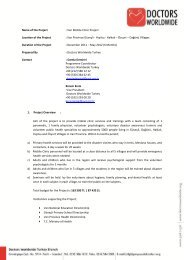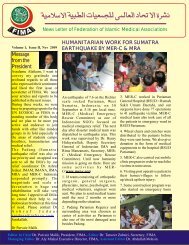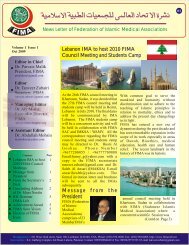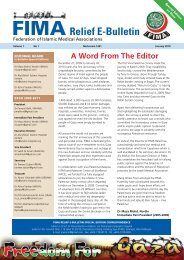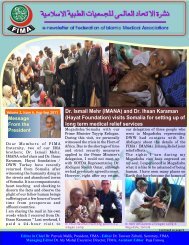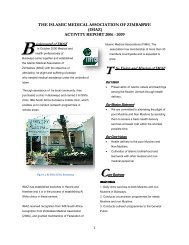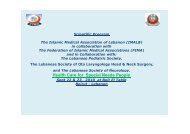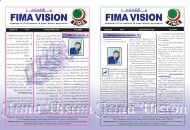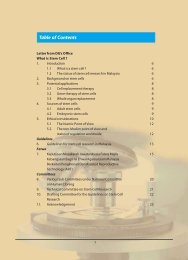FIMA Year Book 2009 - Federation of Islamic Medical Associations
FIMA Year Book 2009 - Federation of Islamic Medical Associations
FIMA Year Book 2009 - Federation of Islamic Medical Associations
Create successful ePaper yourself
Turn your PDF publications into a flip-book with our unique Google optimized e-Paper software.
Quality Assurancebusiness. None <strong>of</strong> these systems<strong>of</strong> quality assurance proved to beeffective as a single entity. Totalquality management (TQM) and itsapplication in a health care institutionhas remarkably improved the standard<strong>of</strong> service provision and pr<strong>of</strong>essionalsatisfaction. Quality assurance canbe achieved through other models <strong>of</strong>quality care as well. There are soundreasons for being quality conscious ina medical organization and especiallywhere teaching and training are alsobeing provided to the health careworkers. (6)There are several reasonsfor today’s quality consciousness:ethical, economical, pr<strong>of</strong>essionalsatisfaction, customer’s need andothers. Quality assurance should be anessential mechanism operating in anyhealth care facility.However, TQM model alone hascertain inherent difficulties in itsapplications in academic institutions.Many questions <strong>of</strong> academic interestcan not be answered in the TQMmodel. Experts have proposed othermodels in addition to TQM to addressthe unanswered questions <strong>of</strong> qualityassurance in academic institutions:Harvey and Knight (1996) presented‘transformation model’ EngagementModel <strong>of</strong> Program Quality’. (7) Theseprograms invest in five separateclusters <strong>of</strong> program attributes, each<strong>of</strong> which contributes to enriching thelearning experiences for students.These includes: Diverse and EngagedParticipant, Participatory Culture,Interactive Teaching and Learning,Connected Program Requirementand Adequate Resources. Thistheory advances a new perspectiveon program quality management,support for students, faculty and basicinfrastructure. In broad terms, theengagement theory emphasizes studentlearning as the primary purpose <strong>of</strong>higher education.In 1998, Bowden and Marton proposedthe University <strong>of</strong> Learning Model (8) ,and postulated that in all the commonlyperceived functions <strong>of</strong> a university:teaching, research or communityinvolvement, the core process is one<strong>of</strong> learning, arguing that ‘quality in auniversity context has a lot to do withthe quality <strong>of</strong> learning and the quality<strong>of</strong> learning has a lot to do with qualities<strong>of</strong> different ways <strong>of</strong> seeing when thelearner widens the range <strong>of</strong> possibilities<strong>of</strong> seeing the same thing.The University <strong>of</strong> learning model ismore appropriate because:1. Teaching, research, and service aredistinguished only by the durationand level at which learningtakes place: teaching serves t<strong>of</strong>acilitate learning at the level <strong>of</strong>the individual student; serviceinvolves learning at the locallevel; and research contributes toknowledge formation on a societywidebasis.2. For students to be able to copewith the unknown future ongraduation, the curriculum<strong>FIMA</strong> <strong>Year</strong><strong>Book</strong> <strong>2009</strong>158




